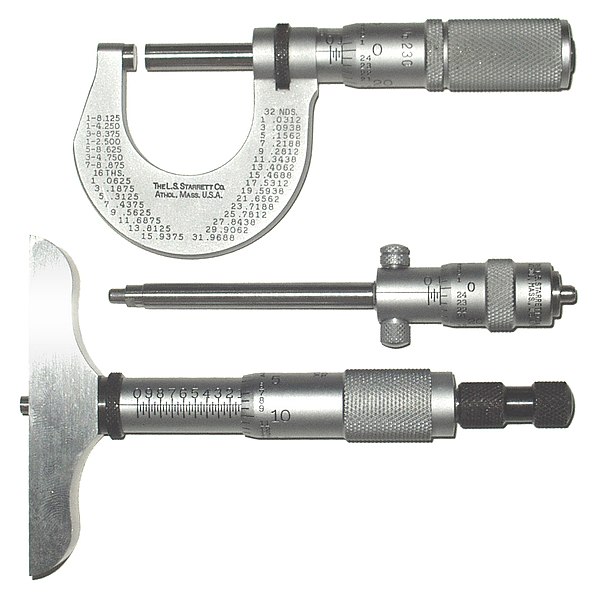The image above shows outside, inside, and depth micrometers.
Introduction: A Brief History of Micrometers
Micrometers, also known as micrometer screw gauges, have been an essential tool for precise measurement in mechanical engineering, machining, and various mechanical trades since the 17th century. The first micrometric screw was invented by English astronomer William Gascoigne in the 1600s, initially used in telescopes to measure angular distances between stars and the relative sizes of celestial objects. Over the years, micrometers have evolved in design and application, with notable contributions by James Watt, Henry Maudslay, and Jean Laurent Palmer, among others. Brown & Sharpe introduced micrometer calipers to the mass market in anglophone countries in 1867, and by the early 20th century, micrometers had become indispensable in fields like tool and die making, machine tool building, and engineering.
Overview: Operating Principles of Micrometers
The basic operating principles of a micrometer involve using a highly accurate screw mechanism to convert small distances that are otherwise difficult to measure directly into large rotations that can be easily read from a scale. This accuracy is achieved through the screw’s lead, which is the distance it moves axially with one complete turn (360°). By amplifying the axial movement to a circumferential movement, micrometers can measure minute differences in the sizes of objects.
Micrometers come in various forms, with classic-style analog micrometers featuring scale markings on the thimble and sleeve, often accompanied by a vernier scale for increased precision. Digital micrometers display the length measurements on an LCD screen, while mechanical-digit versions resemble car odometers with numbers that “roll over”. In any form, micrometers have been an essential tool for precision measurement in a variety of fields and applications for centuries.
Types of Micrometers:
- Inside Micrometers: Used to measure inner dimensions.
- Outside Micrometers: Used to measure outside dimensions.
- Depth Micrometers: Used to measure depth dimensions.
How to Use an Outside Metric Micrometer:
- Clean the micrometer: Wipe down the anvil and spindle surfaces with a clean cloth to remove any dirt or dust, ensuring accurate measurements.
- Secure the object: Make sure the object you are measuring is secure, either through clamping or using a dedicated fixture.
- Position the micrometer: Loosen the thimble and position the spindle and anvil on either side of the object being measured.
- Tighten the micrometer: Turn the thimble clockwise to move the spindle towards the object until the spindle and anvil are in contact with the object. Use the ratchet stop to prevent excessive force, which can result in inaccurate measurements.
- Read the measurement: For traditional micrometers, read the sleeve, thimble, and Vernier scales to obtain the measurement. For digital micrometers, read the digital display.
How to Read a Traditional Micrometer Scale:
- Determine the micrometer type: This provides the base measurement (e.g., 100mm for a 100mm-125mm micrometer).
- Read the sleeve scale: This gives the next two digits and the first decimal of the measurement (e.g., 05.5mm).
- Read the thimble scale: This provides the additional decimal millimeter measurements (e.g., 0.28mm).
- Read the Vernier scale (if present): This offers even more precision (e.g., 0.003mm).
- Add up the measurements: Combine the values obtained from the micrometer type, sleeve scale, thimble scale, and Vernier scale to get the total measurement (e.g., 105.783mm).
How to Read a Digital Micrometer:
A digital micrometer provides a digital readout as the thimble is turned, making it easier to read and reducing operator error. However, digital micrometers are generally more expensive than traditional micrometers.
Micrometer Maintenance and Tips:
- Clean the micrometer before and after use, taking care not to damage the measuring faces.
- Calibrate the micrometer when necessary using an adjusting wrench to ensure accurate measurements.
- Store the micrometer in an environment free of heat, dust, humidity, oil, and mist. For digital micrometers, remove the batteries if they will be stored for an extended period.
By understanding the different types of micrometers and their proper usage, you can make accurate measurements for various applications.


